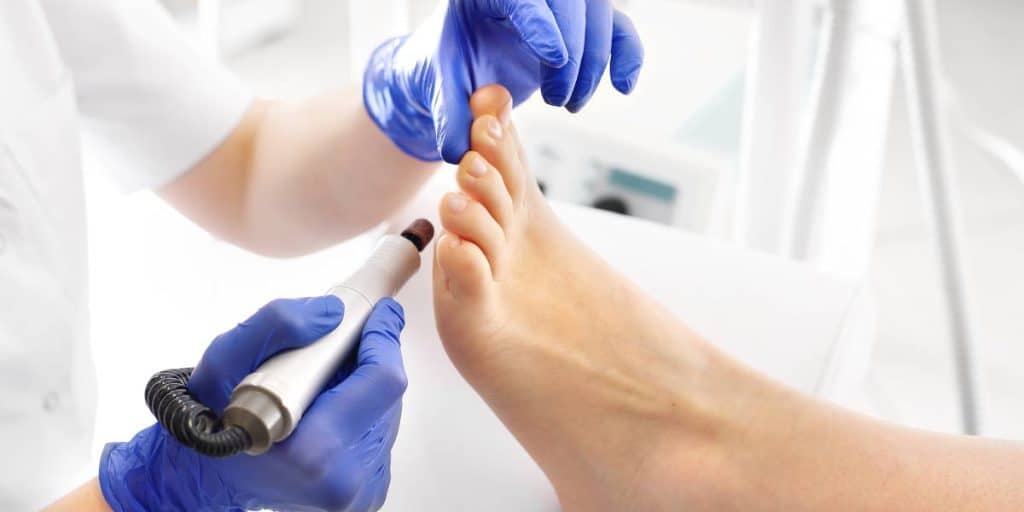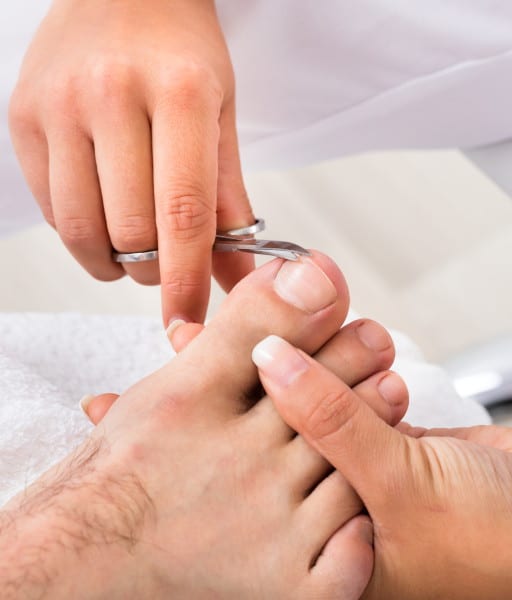A medical pedicure (aka a medi-pedi) is a sterile procedure tailored to the needs of the individual patient. The service is completed by a specialist in podiatry and nail care. A medical manicure is the clinical version of your favorite beauty treatment.
A medical manicure involves
- the removal of dead skin by buffing the heels with professional, medical-grade equipment
- mending cracked dry heels
- professional nail nipping (removal of cuticles and hangnails)
- filing, shaping, and buffing the toenails
- the removal of blisters, corns, calluses, or ingrown toenails
The final step is to thoroughly moisturize the feet; moisturizing the feet can help prevent several skin conditions.
A waterless procedure, the medi-pedi avoids cross-contamination. If someone has cracked heels or a wound on their foot, soaking their feet in water would increase the risk of infection as microorganisms can enter through the broken skin.
Medical pedicures are useful corrective- and preventive-care tools. Incorporating medi-pedis into your routine can prevent problems that might need more invasive correction. Even if you don’t currently have foot problems, regular medical pedicures are great preventive care and are safer and more private than a traditional nail salon.

What does a podiatrist do during a medical pedicure?
A podiatrist specializes in the assessment, management, and prevention of disorders and diseases of the foot. At an appointment for a medical pedicure, the podiatrist will start by taking a full medical history, including current and past health conditions, current medications, and the main reason for the visit.
The podiatrists at University Foot & Ankle Institute will then check for the following:
- adequate circulation (blood flow)
- proper nerve function
- signs of infection (bacterial, fungal, or viral)
- skin pathologies (callus, corns, psoriasis, eczema/dermatitis)
- nail abnormalities (thickened, discolored, or ingrown nails)
What’s the difference between a traditional pedicure and a medical pedicure?
A traditional (salon) pedicure usually means a trip to your favorite neighborhood nail salon. Think regular pedicure. Think sandal-ready feet.
A salon pedicure is a beauty treatment for toenails and feet. A manicurist fills a basin with warm water for soaking the feet, then removes dead skin, moisturizes the feet, trims, files, and shapes the toenails, and cuts back the cuticles. Its focus is on indulgence, pampering, and relaxation.
And the grand finale is the foot massage and the nail polish (your favorite color, of course!).
If the goal is to groom your feet with freshly painted toenails, a salon pedicure may be the right choice for you.
The difference lies in the purpose and details of the treatments.
Spa pedicure vs. medical pedicure
A medi-pedi is a medical-grade pedicure distinctively different from a salon pedicure:
- A medi-pedi is a service that bridges podiatry and basic nail care with a focus on the assessment and treatment of foot issues, rather than aesthetics.
- It’s completed by a foot care specialist — either a podiatrist or certified medical nail technician — who is an expert in podiatry and nail care.
- Medi-pedis are performed in a private, sterile room at your doctor’s office for optimal comfort and sanitation.
- Podiatrist pedicures ensure the health of your feet by managing existing foot problems as well as detecting and treating issues in their early stages.
- A medi-pedi addresses and treats ailments such as:
- cracked heels
- nail discoloration
- a buildup of skin in the nail folds and cuticles
- dead skin removal (exfoliation)
- foot pain
- corn and callus removal
- thick nails
- ingrown toenails
- fungal infections including athlete’s foot and nail fungus
- warts
- All treatments use medical-grade products and freshly sterilized instruments for each client. The sterilization process removes microorganisms such as fungi, bacteria, viruses, and spores to prevent the transfer between individuals.
- Much like a salon pedicure, a medi-pedi treatment lasts about 45 minutes.
- A medi-pedi is pain-free, often soothing and relaxing.
Clinical pedicures are not just for people experiencing dry, cracked skin and other foot issues. These pedicures are for everyone. They are especially recommended for athletes and anyone who spends a lot of time on their feet.
What medical conditions are best suited for medical pedicures?
Those who suffer from certain underlying medical conditions are great candidates for a medical pedicure. Such conditions include:
Diabetes
Diabetics have a high risk of developing foot ulceration and/or infection because of decreased blood flow and poor circulation. Infection is dangerous and can lead to gangrene, and ultimately to amputation if it becomes severe.
A medical pedicure is a good choice for diabetics who maintain controlled blood sugar levels and don’t have peripheral artery disease. Diabetics must be very careful about maintaining the health of their feet and preventing infection. Proper nail care takes on a whole new level of importance for them.

Cancer
Many different types of cancer treatments may cause changes in your nails and skin. For example:
- Radiation therapy may cause skin irritation in the areas treated. The skin may become red, sensitive, dry, itchy, or moist.
- Chemotherapy may cause nails to crack and darken. It may also cause dry, itchy skin and photosensitive skin that burns easily.
- Stem cell transplants may cause rashes and blisters on the skin.
- Immunotherapy may cause rashes or other nail and skin issues.
A medical manicure would be optimal in these circumstances. It would keep the nails and skin clean, protected, moisturized, and monitored for cracks and breaks in the skin and nails. The medical recommendation is that the nails be cut short, and cuticles should not be cut.
Autoimmune diseases
Autoimmune diseases can affect almost any part of the body including skin and nails. Antibodies, components of the immune system, attack healthy cells throughout the body, causing autoimmune diseases, including:
- Lupus — Lupus causes excessively thick or rough nail folds and cuticles with spots or hyperpigmentation. Changes in the skin, hair, and nails are very common, occurring in 85% of patients.
- Rheumatoid arthritis — RA causes changes in the nails, such as vertical ridges, yellowing, and thickening.
A medical pedicure provides the personalized treatment, care, and monitoring that those afflicted require.
Calluses can be removed, and cracked heels buffed without risk of infection due to an unsterile procedure. Medical pedicures are a safe option as there’s minimal risk of cuts or infection.
Foot care, for the elderly, is an imperative part of their overall healthcare plan. The expertise of a podiatrist may be necessary if an elderly patient has thick or deformed toenails due to a fungal infection. Some have compromised immune systems, cancer, or diabetes.
Are medical pedicures covered by insurance?
It depends. The services included in a medical pedicure may be reimbursed by insurance carriers. But whether these services are covered by your insurance depends upon the insurance company and the limitations of the insurance policy you purchased.
Pay attention to your feet and treat them with care. Keep those toenails in great shape, whether you’re at home, at the spa, or in the podiatrist’s office.
Why choose University Foot and Ankle Institute for a medical pedicure near me?
Whether you need to find the right footwear, treat an injury, or get advice on proper foot care, we’re here to help. Our podiatrists offer the most advanced podiatry care and the highest success rates in the nation. We are nationally recognized foot and ankle specialists and leaders in researching, diagnosing, and treating all foot and ankle conditions and common injuries.
For a consultation please call (877) 736-6001 or make an appointment online now.
Our podiatrists take patients’ safety seriously. Our podiatry facility’s Covid-19 patient safety procedures exceed all the CDC’s coronavirus pandemic recommendations. Masks are always required in our institutes.
University Foot and Ankle Institute is conveniently located throughout Southern California and the Los Angeles area. Our foot doctors are available at locations in or near Santa Monica, Beverly Hills, West Los Angeles, Manhattan Beach, Northridge, Downtown Los Angeles, Westlake Village, Granada Hills, and Valencia.
- Could Feet Be the Windows to Your Health? - May 24, 2024
- Is Foot Analysis Better than Horoscopes? What Do Your Toes Reveal About Your Personality? - May 7, 2024
- The Link Between Foot Health and Posture - April 14, 2024